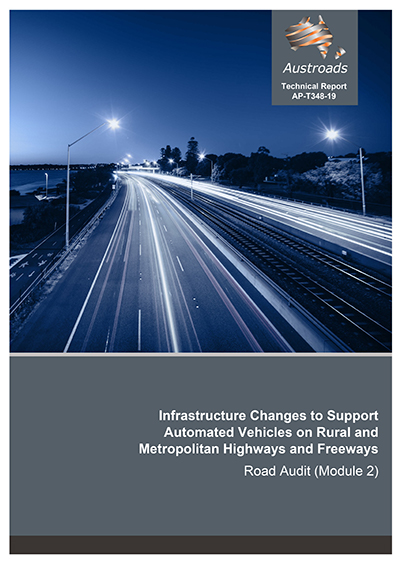Connected and Automated Vehicles

- Publication no: AP-T348-19
- ISBN: 978-1-925854-42-8
- Published: 8 October 2019
- PDF (free) Download
This project undertook an extensive field audit of Australian and New Zealand freeways and highways to inform the assessment of their readiness for active safety systems and automated driving.
The road audit included more than 8 million individual line segments and 8 000 signs, on a 25 000 km sample of the road network which, although extensive, still represents less than 2% of the total network.
The audit found that most freeways and highways of Australia and New Zealand can for the most part currently support safety assistance system (ADAS) operation and connected and automated vehicle (CAV) lane positioning, with good quality lines and cellular availability.
The presence of left and right lane line markings is critical for lane positioning and there are significant proportions of the road network without edge lines. Increasing the use of edge lines and dividing lines (lane lines and centre lines) will provide a clear immediate benefit for both automated driving and human drivers.
- Summary
- 1. Introduction
- 1.1 Background
- 1.1.1 Module 1 overview
- 1.1.2 Findings from Module 1
- 1.2 Audit Purpose
- 1.3 Project Scope
- 1.4 Report Structure
- 1.1 Background
- 2. Requirements for CAV Operation
- 2.1 Vehicle Automation
- 2.2 Road Network Readiness
- 2.3 Implications for Physical Road Infrastructure
- 2.4 Implications for Digital Infrastructure
- 3. Method
- 3.1 Overview of Approach
- 3.2 Road Network Scope
- 3.3 Functional Class Definitions
- 3.4 Data Sources
- 3.5 Data Collection
- 3.5.1 Camera configuration
- 3.5.2 Digital imagery data
- 3.6 Data Processing
- 3.6.1 Data alignment method
- 3.6.2 Data aggregation
- 3.7 Manual Processing
- 3.7.1 Line marking
- 3.7.2 Signs
- 3.7.3 Other attributes
- 3.7.4 Rating field of view
- 3.8 Post-processing
- 3.9 Real-time Processing
- 3.10 Cellular Coverage
- 3.11 Summary of Assessment Method
- 3.12 Threshold Values
- 3.13 Audit Coverage
- 3.13.1 Physical infrastructure
- 3.13.2 Digital infrastructure
- 4. Road Survey Audit Results
- 4.1 Line Markings
- 4.2 Road Signs
- 4.3 Digital Infrastructure
- 4.3.1 Cellular data
- 4.3.2 High-definition maps
- 4.4 Temporary Conditions and Events
- 5. Real-Time Processing Results
- 5.1 Line Markings – Real-Time Results
- 5.1.1 Example of line classification
- 5.2 Road Signs – Real-time Results
- 5.2.1 Example of incorrect sign identification
- 5.1 Line Markings – Real-Time Results
- 6. Manual Validation and Comparison
- 6.1 Coverage
- 6.2 Line Markings
- 6.2.1 Line markings – manual results
- 6.2.2 Line markings – post-processing validation
- 6.2.3 Line markings – real-time detection validation
- 6.2.4 Line markings – effect of line attributes on real-time performance
- 6.2.5 Line markings – comparison of methods
- 6.2.6 Example of poor lighting conditions
- 6.3 Road Signs
- 6.3.1 Signs – manual results
- 6.3.2 Signs – post-processing validation
- 6.3.3 Example of electronic sign display rate issue
- 6.3.4 Signs – real-time validation
- 6.3.5 Signs – comparison of methods
- 6.4 Lane Discontinuities and Changes
- 7. Case Studies
- 7.1 Case Study Conditions
- 7.1.1 Ideal conditions – Class 1
- 7.1.2 Ideal conditions – Class 3
- 7.1.3 No edge line
- 7.1.4 Adjacent road sign
- 7.1.5 Roadworks – extra lines
- 7.1.6 Roadworks – no lines – unsealed
- 7.1.7 Roadworks – no lines – sealed
- 7.1.8 Audio-tactile edge lines
- 7.1.9 Poor light conditions – shadows – real-time
- 7.1.10 Poor light conditions – shadows – post-processed
- 7.1.11 Poor light conditions – reflective surfaces and low contrast
- 7.1.12 Median lines
- 7.1.13 Poor light conditions – night
- 7.2 Summary of Case Study Findings
- 7.1 Case Study Conditions
- 8. Key Findings
- References
- Appendix A Manual Rating Information
- Appendix B Outputs and Validation Method
